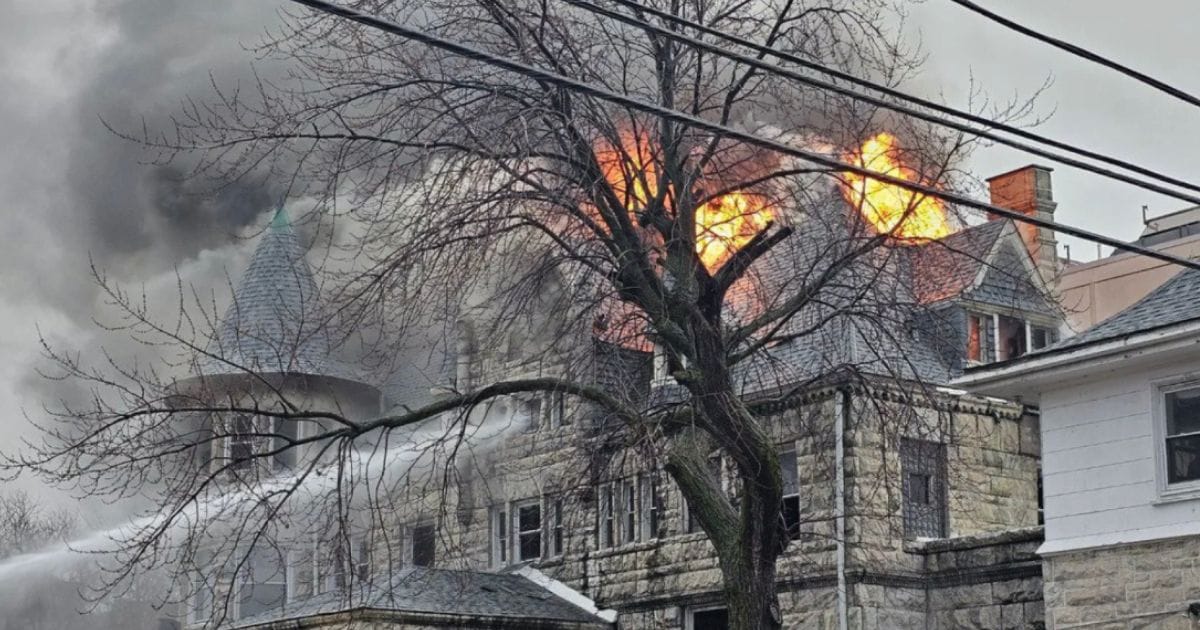Firefighters battling fire at Swift Mansion
The historic Swift Mansion in Bronzeville faces an uncertain future after a devastating fire destroyed the roof on Sunday morning, December 3.
Despite being on the National Register of Historic Places, the 131-year-old manse is not protected from demolition because it’s not officially a Chicago landmark. That designation prevents historic buildings from being demolished.
Now, with its roof destroyed, extensive water damage and an estimated hundreds of thousands of dollars in renovation costs, the Swift Mansion’s future is in jeopardy, as Chicago building inspectors prepare a report to determine whether the structure is unsafe and unsound.
If deemed so, the city can order the building, once the headquarters of the Chicago Urban League, to be demolished. It may suffer the same fate as Englewood’s historic Antioch Missionary Baptist Church, which was demolished after a fire in 2022 destroyed the roof and left the structure unsafe.
With its grand oak staircase, extensive oak paneling and elegant staircase, the 37-room Swift manse once hosted and entertained the wealthy, and later became an important part of Chicago’s rich Black History.
Chicago police have opened an arson investigation after officials said the fire started in the building’s stairwell. Officials say the blaze started around 11:30 a.m. on Sunday, December 3. Around 2:30 p.m., the fire rekindled and flames were seen coming from the roof.
Owner James Otis told WGN News that 10 people were living in the manse at the time and he believes a resident, unhappy with the recent plans to renovate, started the fire.
“We believe somebody did it intentionally ’cause they were upset with having to leave ’cause we are gonna renovate,” Otis told WGN.
Otis, whose mother and former mansion owner, Christine Perkins, died several years ago, said he was in the manse at the time and tried his best to get the fire under control.
“The Fire Department and the police had to pull me from the second floor ’cause I wasn’t leaving until I tried to put out the fire,” Otis told WGN.
In a Crusader article written in 2017, it was reported that the “Swift Mansion faces uncertain future.” On February 13 of that year, Christine and Maurice (Perkins), the founders of the Inner City Youth-Adult Foundation, put the manse up for sale for $1.3 million. But too many repair and renovation costs may have discouraged buyers from owning it.
“We’re hopeful that someone will come along, fix the place and take over the work,” Christine told the Crusader at the time.
Facing rising maintenance costs, Christine said she and her husband put the manse up for sale so she and her husband could retire.
Christine said they planned to continue helping youth in some capacity, but traveling and relaxing are a big part of the couple’s future.
The Perkins have hosted tours, forums, workshops, and community barbeques at the Swift mansion. As part of the Transitional Living Life Skills Program, the Perkins helped non-violent inmates from a facility in Sheridan, Illinois, make a smooth transition into the job market. Hundreds of youths have obtained jobs through the Perkins’ program.
Christine in 2017 told the Crusader she and her husband, Maurice Perkins, bought the manse in 1995 for an undisclosed sum after she overheard while in an elevator that the building was going to be demolished.
It was the second time the Swift Mansion was threatened with the wrecking ball. Earlier, in 1951, plans to demolish the mansion were stopped after one owner announced plans to remodel the structure, according to the Chicago Sunday Tribune.
According to the Chicago Landmarks Commission, the mansion is not designated as an official Chicago landmark, which protects structures from demolition.
Christine told the Crusader in 2017 that her husband twice tried to obtain Chicago Landmark designation for the mansion but grew discouraged from the application process.
Peter Strazzabosco, deputy commissioner of community development, said there was a suggestion to designate the Swift Mansion as a Chicago landmark on November 20, 2012, but no formal request or application was submitted.
Aldermen usually nominate buildings for Chicago landmark status. But after the article was published, Alderman Pat Dowell (3rd) told the Crusader the manse had too many code violations to be eligible to become a Chicago landmark.
The Crusader reported in 2017 that the manse was coded orange on the National Register of Historic Places (NRHP). It means that should a buyer want to tear down the Swift Mansion, he must wait 90 days while the Department reviews the request to demolish the property. But several structures in Chicago neighborhoods have met their fate, despite being on the NRHP.
The Swift Mansion was built in 1893 before the Great Migration brought thousands of Blacks to Chicago from the South. Back then Bronzeville was called Grand Douglas, and was a predominately white neighborhood, with rows of mansions lining Michigan Avenue.
Gustavo Swift, a prominent, wealthy meatpacker, built the mansion for his daughter Helen as a wedding gift. Helen and her husband, Edward, lived in the mansion until 1904 when it was occupied by several more family members.
A funeral home operated out of the mansion before the Chicago Urban League used it as its headquarters for decades until it moved next door, to 4510 S. Michigan, in 1984.
The mansion languished vacant for a decade before the Perkins bought it in 1996 for $101,000, according to public records with the Cook County Recorder of Deeds.
The 10,200-square-foot graystone Swift manse has 37 rooms, a chef’s kitchen and a 1,500-square-foot ballroom. There is also a three-story coach house at the rear of the property.
-
Erick Johnsonhttps://chicagocrusader.com/author/erick-johnson/
-
Erick Johnsonhttps://chicagocrusader.com/author/erick-johnson/
-
Erick Johnsonhttps://chicagocrusader.com/author/erick-johnson/
-
Erick Johnsonhttps://chicagocrusader.com/author/erick-johnson/






